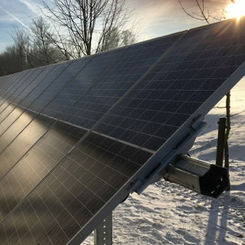
Photovoltaik
Für die Lieferanten von PV-Unterkonstruktionen erstellen wir in enger Zusammenarbeit
mit der Planung und Produktion die statischen Berechnungen für weltweite Anlagenorte.
Ständige Weiterentwicklungen für Freiland-, Tracker- und Dachkonstruktionen
unter Berücksichtung des jeweiligen Standorts des Projektes sowie dessen
entsprechenden Besonderheiten und Belastungen sowie die international
unterschiedlichen Normenvorschriften und Anforderungen für Prüfzertifikate
fordern eine permanente Weiterbildung unseres Fachwissens.
Freiland-Photovoltaik-Anlagen
Diese Art von Kraftwerken produzieren ökologisch und effizient Strom
und verfügen gleichzeitig über eine immense Leistungsfähigkeit.
Die Solarmodule werden auf Metallgestellen angebracht und in langen
parallel laufenden Reihen aufgestellt. Um Verschattung der Module zu vermeiden,
werden die Systeme mit ausreichend Abstand zueinander montiert.
Als Flächen dienen häufig nicht genutzte Militär-, Industrie- und Gewerbeflächen
oder auch Flächen entlang Autobahnen, Schienenwegen oder auf Mülldeponien.
Der Ausbau der erneuerbaren Energien ist ein wichtiger Bestandteil der Energiewende,
in diesem Zusammenhang ist das Erneuerbare-Energien-Gesetz (EEG)
erstmals im Jahr 2000 in Kraft getreten und seither stetig weiterentwickelt worden.
Ziel des EEG ist es, die Energieversorung umzubauen und den Anteil der
erneuerbaren Energien an der Stromversorgung bis 2050 auf mindestens 80% zu steigern.
Die Module des Trackersystems können sich durch ein integriertes Nachführsystem
automatisch ausrichten und den Ertrag somit maximieren. Mit der Fähigkeit, sich um
eine einzige zentrale Achse zu drehen, können Trackersysteme die Sonne vom
Sonnenaufgang bis zum Sonnenuntergang verfolgen.
Der Einfallswinkel wird minimiert, der Sonnengewinn maximiert.
Tracker bieten zudem einige einzigartige Konstruktionssituationen, die in Systemen mit
fester Neigung nicht auftreten. Sie sind so konzipiert, dass sie dynamischen und statischen
Kräften durch aktive und passive Schutzmethoden widerstehen.
Tracker-Photovoltaik-Anlagen
Als Floating-PV (Floating-Photovoltaik) wird die Tragwerksplanung von
schwimmenden Systemen für Photovoltaikmodule nach internationalen Standards bezeichnet.
Dabei werden die Photovoltaik-Module auf Booten von kaltgeformten
Stahlstrukturen getragen, neben der Windlast muss hier somit auch die
Wellendynamik berücksichtigt werden.
Gemeinsam mit der Firma ZIMMERMANN PV-Stahlbau GmbH & Co. KG
haben wir dafür spezielle Wellenbrecher entwickelt. Der kühlende Effekt des Wassers
wirkt sich sehr vorteilhaft auf die Module aus.
Floating-Photovoltaik-Anlagen
Agri-Photovoltaik-Anlagen
Agri-PV verbindet die Ernte von Lebensmitteln mit der Ernte von Energie.
Semi-transparente Module können zum Einsatz kommen.
Forscher der US-amerikanischen Oregon State University haben in einer in
der Nature veröffentlichten Studie ausgerechnet, dass in der Theorie
weniger als 1% der weltweit für den Ackerbau genutzten Flächen ausreichen würde,
um den gesamten globalen Strombedarf zu decken.
In der Praxis müssten laut der Studie noch Lösungen für die Speicherung
und den Transport des Stroms gefunden werden.
Auch das Fraunhofer Institut für Solare Energiesystem ISE konnte in ersten Tests
am Bodensee eine Steigerung der Landnutzungsrate auf bis zu 186% feststellen.
Die Demeter-Hofgemeinschaft in Heggelbach am Bodensee konnte bei den
angebauten Kulturen Winterweizen, Kartoffeln und Sellerie einen höheren Ertrag
als auf Referenzflächen ohne Solarmodulen verzeichnen.
"Bezogen auf Kartoffeln ergibt sich eine Steigerung der Landnutzungseffizienz um 86% pro Hektar",
so Projektleiter Stephan Schindele vom Fraunhofer ISE. Bei der Hofgemeinschaft in Heggelbach
wird der Solarstrom direkt vor Ort gespeichert. Somit ergeben sich für die Landwirte durch
Synergieeffekte zusätzliche Einkommensquellen.
In Entwicklungslädern und ariden Gebieten haben große Teile der Landbevölkerung
keinen Zugang zu bezahlbarer Energie, zudem werden die wertvollen Trinkwasserressourcen
oftmals für die Bewässerung von landwirtschaftlichen Kulturen verwendet.
Agro-PV-Anlagen würden Energie bereitstellen und gleichzeitig durch die
Verschattung der Ackerflächen den Bewässerungsbedarf reduzieren.
Auch die oftmals zu starke Sonneneinstrahlung und Hitze könnte durch die
partielle Beschattung optimiert werden.
In einem Projekt im Rahmen des EU-Programms Horizont 2020 prüfen Fraunhofer-Forscher, wie sich Agro-PV-Anlagen auf den Wasserhaushalt (verringerte Verdunstung + Regenwassergewinnung) auswirken.






































